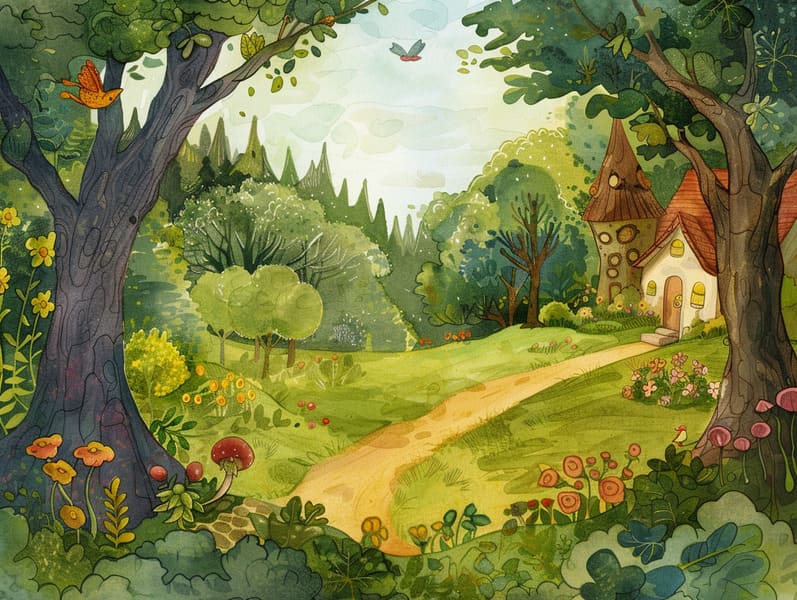
Traditional fairy tales have legendary status. These tales have been narrated from one generation to the next long before they were ever published. They originated from a variety of cultures, including American traditions. They were initially shared among adults, often carrying themes and messages concerning the societal norms and beliefs of the time.
The renowned Brothers Grimm, Jacob and Wilhelm Grimm, were among the first to collect and release many of these beloved narratives. Their anthology, "Grimm's Story Collection," included stories like "Cinderella," "Hansel and Gretel," and "The True Story of Snow White," which have since become essentials in the world of classic fairy tales. Similarly, Hans Andersen's enchanting stories, such as "The Mermaid's Tale," and "The Duckling that Could," have gained the love worldwide, cementing their place in the pantheon of classic fairy tales.
Though they are old, fairy tales remain as impactful as ever, especially as children's bedtime stories. These enchanting tales are now available in different formats, including richly illustrated books, captivating animations, and digital fairy tales.
Their lasting appeal can be ascribed to several captivating elements:
Vital Lessons: Traditional fairy tales often whisper important moral lessons. Narratives like "The Shepherd Boy and the Wolf" teach the value of being truthful, while "The Story of the Tortoise and the Hare" exemplify the qualities of resolve and humbleness. These stories offer the young clear distinctions between moral and immoral, forming their moral compass in a tender yet deep way.
Kindness and Comprehension: Classic fairy tales frequently portray beings facing obstacles and hardships, inciting young listeners to empathize with their struggles and encourage their triumphs. For instance, "The Tale of Beauty and the Beast" reveals the virtue of seeing beyond looks to see the real character of a being, developing kindness and comprehension.
Cultural Appreciation: Many ancient fairy tales are interwoven with the cultural contexts from which they originated. Delving into these fairy tales can provide enlightening views into different heritages, cultivating a sense of world awareness and comprehension.
Fantasy and Innovation: The whimsical elements in old fairy tales—spells and potions—ignite children’s visions. These tales transport readers to enchanted realms, kindling innovative dreams and a sense of curiosity that remains a lifetime.
Classic fairy tales are not only bewitching but also illuminating. They work as enchanted tools in nurturing various cognitive and emotional skills in little ones. When ancient fairy tales are voiced, they foster communication skills by showing new this site words and detailed sentence structures. This practice also promotes listening skills and attention, as young readers listen intently, expectant to see what happens next.
Furthermore, exploring the themes and characters of ancient fairy tales can improve problem-solving abilities and problem-solving abilities. Little ones are shown to spot patterns, anticipate outcomes, and understand cause and effect. These deliberations also facilitate children communicate their thoughts and feelings, advancing their emotional intelligence.
In today’s digital era, the existence of online storybooks has made these stories more reachable than ever. Websites and applications make available vast collections of popular fairy tales that can be read or listened through anytime, anywhere. Fairy tales read aloud are particularly common, offering an interactive method for children to savor these alluring stories. Sound books and read-to-me stories lead characters and settings to life, often joined by whimsical melodies and background music that raise the narrative experience.
The unending appeal of classic fairy tales lies in their ability to evolve to present days while maintaining their fundamental ideas. Contemporary takes of these tales often spotlight more representative figures and modern settings, making them understandable to today’s audience. However, the key lessons of courage, humanity, and equity remain unchanged, continuing to connect with young readers of all ages.
Classic fairy tales also offer a sense of ease and familiarity. They bequeath a organized narrative with a definite beginning, middle, and end, often closing with the closure of conflicts and the triumph of good over evil. This certainty can be comforting for kids, rendering a sense of sturdiness in an fluid world.
Classic fairy tales continue to fascinate and instruct new generations, maintaining their elegance and impact in modern society. As nighttime stories for kids, they afford a perfect blend of enchantment and education, enhancing moral values, empathy, and creativity. The existence of digital fairy tales and the commonness of fairy tales voiced ratify that these classic tales remain acquirable to new generations.
By perpetuating and distributing these narratives, we continue to treasure the rich tapestry of legends and cultural heritage. Whether you are experiencing a richly illustrated book, discovering a web collection, or playing an spoken story, the radiance of popular fairy tales is always within reach. These fairy tales emphasize of the persistent power of fairy tales and its ability to hold us together across generations and cultures.
Even if you are viewing a vividly illustrated book, accessing a online library, or listening via an voice book, the appeal of classic fairy tales is always within reach.
These fairy tales demonstrate of the steadfast spell of stories and its ability to bring us together across eras and regions, making a tie that fascinates and enlightens alike.